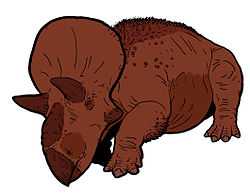Turanoceratops
| Turanoceratops Temporal range: Late Cretaceous, 90Ma | |
|---|---|
 | |
| Restoration | |
| Scientific classification | |
| Kingdom: | Animalia |
| Phylum: | Chordata |
| Clade: | Dinosauria |
| Order: | †Ornithischia |
| Superfamily: | †Ceratopsoidea |
| Genus: | †Turanoceratops Nesov et al., 1989 |
| Species: | † T. tardabilis |
| Binomial name | |
| Turanoceratops tardabilis Nesov et al., 1989 | |
Turanoceratops ("Turan horn face") is a genus of ceratopsian dinosaur, possibly a ceratopsid. Its fossil remains were recovered from the Bissekty Formation of Uzbekistan, dating to the late Cretaceous Period (mid-late Turonian stage) about 90 million years ago. If it is a ceratopsid, it would be one of few members of the family known from outside North America, and would be among the earliest ceratopsids.
Classification
Turanoceratops belonged to the Ceratopsia (the name is Greek for "horned face"), a group of herbivorous dinosaurs with parrot-like beaks which thrived in North America and Asia during the Cretaceous Period, which ended 66 million years ago. All ceratopsians became extinct at the end of this period.

A 2009 study led by Hans-Dieter Sues analysed additional fossil material of Turanoceratops and concluded that, contrary to expectations, it represented a true (though "transitional") member of the family Ceratopsidae. If correct, it would represent an Asian ceratopsid. At the time of publication this would have been unique, as all other ceratopsids known to that point were from North America.[1] Some scientists, such as Andrew Farke, disagreed with Sues' findings. Farke and colleagues ran an independent phylogenetic analysis of the new Turanoceratops fossils and found that it was a close relative of Ceratopsidae (the immediate sister group) but was not a true member of that clade.[2] Sues and Alexander Averianov criticised that analysis, arguing that Farke and colleagues misinterpreted or mis-coded some characteristics of the fossil in their analysis.[3] However, Xu et al. (2010) conducted a phylogenetic analysis and concluded that Turanoceratops was more derived than Zuniceratops and was outside of Ceratopsidae, because it lacks several important synapomorphies of this group.
Diet
Turanoceratops, like all ceratopsians, was a herbivore. During the Cretaceous, flowering plants were "geographically limited on the landscape", and so it is likely that this dinosaur fed on the predominant plants of the era: ferns, cycads and conifers. It would have used its sharp ceratopsian beak to bite off the leaves or needles.
References
- ↑ Sues, H.-D., and Averianov, A. (2009). "Turanoceratops tardabilis—the first ceratopsid dinosaur from Asia." Naturwissenschaften, doi:10.1007/s00114-009-0518-9.
- ↑ Farke, A., Sampson, S.D., Forster, C.A., Loewen, M.A. (2009). "Turanoceratops tardabilis—sister taxon, but not a ceratopsid." Naturwissenschaften, 7 May 2009. doi:10.1007/s00114-009-0543-8.
- ↑ Sues, H.-D. and Averianov, A. (2009). "Phylogenetic position of Turanoceratops (Dinosauria: Ceratopsia)." Naturwissenschaften, 20 May 2009. doi:10.1007/s00114-009-0552-7.
External links
- Ceratopsia at Thescelosaurus!